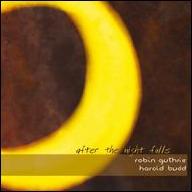Though interested in music from an early age, Harold Budd was 30, already married, and with children of his own by the time he graduated from the University of Southern California with a degree in musical composition in 1966. He became a respected name in the circle of minimalist and avant-garde composers based in Southern California during the late '60s, premiering his works "The Candy-Apple Revision" and "Unspecified D-Flat Major Chord and Lirio" around the area. In 1970, he began a teaching career at the California Institute of Arts, but continued to compose while there, writing "Madrigals of the Rose Angel" in 1972.
After leaving the Institute in 1976, Budd gained a recording contract with the Brian Eno-affiliated EG Records and released his debut album, The Pavilion of Dreams, in 1978. Two years later, he collaborated with Eno on one of the landmark albums of the ambient style, Ambient 2: The Plateaux of Mirrors. After recording two albums for Cantil in 1981 (The Serpent [In Quicksilver]) and 1984 (Abandoned Cities), Budd again worked with Eno on 1984's The Pearl. The Moon and the Melodies, a collaboration with the Cocteau Twins (credited by their full names), was released by 4AD in 1986. A contract with Eno's Opal Records resulted in one of Budd's most glorious albums, 1988's The White Arcades, recorded in Edinburgh with Cocteau Twins guitarist Robin Guthrie. Budd left Opal after 1991's By the Dawn's Early Light, and recorded two albums for Gyroscope: Music for 3 Pianos (with Ruben Garcia and Daniel Lentz) and the lauded Through the Hill, a collaboration with Andy Partridge of XTC. In the mid-'90s, he recorded albums for New Albion and All Saints before signing to Atlantic for the release of The Room in mid-2000. John Foxx, best known for his work with synth-pop icons Ultravox, went into the studio with Budd for the recording of 2003's Translucence/Drift Music.
In 2004, Budd decided to retire, claiming he had said all he wanted to, and that he "didn't mind disappearing." His "final" outing, Avalon Sutra/As Long as I Can See My Breath, appeared on David Sylvian's Samadhi Sound imprint as a double disc. The album featured 14 new pieces, some recorded solo, some recorded with saxophonist Jon Gibson, and some with a string quartet. Budd apparently changed his mind about retirement, and his collaboration with Eraldo Bernocchi, Fragments from the Inside, issued on Sub Rosa, arrived in the spring of 2005. Back to composing and recording, Budd signed to Darla in late 2007. He began working with producer Clive Wright that same year. Song for Lost Blossoms was issued in 2008, followed by the release of Candylion in mid-2009; the pair also worked together on 2010's Little Windows.
Robin Guthrie and Harold Budd gathered for another collaborative album, Bordeaux, in 2010, and Eraldo Bernocchi joined the pair to record 2011's Winter Garden. Budd's previous collaboration with Foxx was reissued with a third disc, featuring pianist Ruben Garcia, as Nighthawks, Translucence and Drift Music. A collection of new solo pieces, In the Mist, was issued by Darla Records in 2011. Budd was accompanied by the Formalist Quartet for the recording of 2012's Bandits of Stature, and he worked with visual artist Jane Maru for Jane 1-11, published by Darla in 2013. 2014 brought a follow-up, Jane 12-21, as well as White Bird in a Blizzard, a film score he wrote in tandem with Robin Guthrie. The Little Glass, which arrived the same year, was created in cooperation with Akira Rabelais. On December 4, 2020, Robin Guthrie issued Another Flower, a previously unreleased album recorded with Harold Budd in 2013. Only four days later, Budd died due to complications from the COVID-19 virus. He was 84 years old. ~ John Bush & Mark Deming, Rovi


















